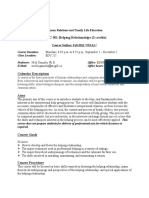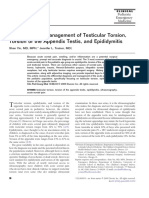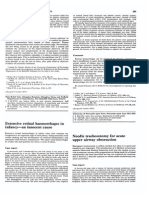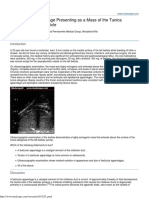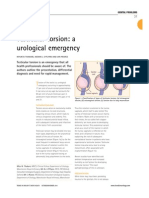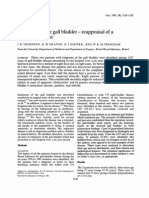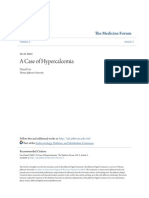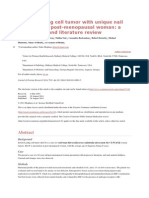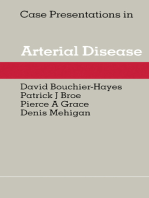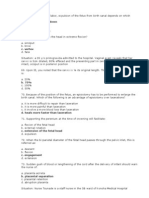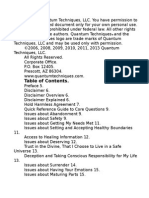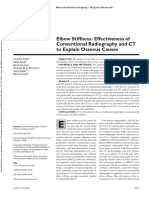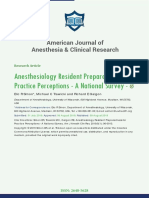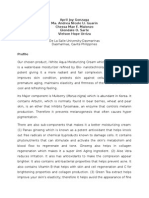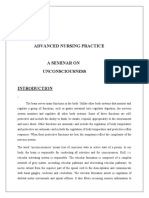Professional Documents
Culture Documents
Case Report Acute Idiopathic Scrotal Edema MILMED-D-13-00103
Case Report Acute Idiopathic Scrotal Edema MILMED-D-13-00103
Uploaded by
YJanitorCopyright
Available Formats
Share this document
Did you find this document useful?
Is this content inappropriate?
Report this DocumentCopyright:
Available Formats
Case Report Acute Idiopathic Scrotal Edema MILMED-D-13-00103
Case Report Acute Idiopathic Scrotal Edema MILMED-D-13-00103
Uploaded by
YJanitorCopyright:
Available Formats
MILITARY MEDICINE, 178, 7:e890, 2013
A Case Report of Acute Idiopathic Scrotal Edema
CPT Michael M. Braun, MC USA*; MAJ Aaron J. Cronin, SP USA; LTC David G. Bell, MC USA
ABSTRACT Acute Idiopathic Scrotal Edema (AISE) is an uncommon cause of bilateral scrotal swelling encountered
in primary care. AISE is usually seen in children; however, several case reports have shown that AISE can occur in adult
males. We present an active duty adult male who presented with AISE while deployed in Afghanistan. The clinical
course of AISE is usually benign with labs and ultrasound being unremarkable. Besides swelling, the most common
symptom tends to be intense scrotal puritis. Treatment for AISE is watchful waiting and conservative therapy. Full
symptom resolution usually occurs within 24 hours.
INTRODUCTION
Acute Idiopathic Scrotal Edema (AISE) is an uncommon
cause of bilateral scrotal swelling found mainly in schoolaged boys. The disease process was first described by Qvist in
1956.1 An extensive literature search found only 10 other case
reports describing this rare disease in adult males over the past
25 years. Herein, we present another rare case of AISE in an
adult male while on deployment in western Afghanistan. The
purpose of this article is to bring awareness of this rare condition in adult males and provide treatment recommendations.
PRESENTATION
A 20-year-old, active duty Marine male presented to his aid
station while deployed in Afghanistan for acute onset of painless bilateral scrotal swelling. The patient awoke to intense
scrotal/penile pruritis when he discovered the scrotal swelling.
He recalls lifting heavy objects the day prior, but denied
any trauma, burns, or chemical substance spills. He routinely
shaved his scrotum and performed this act several days prior.
Review of systems revealed no fevers, chills, recent illnesses, nausea or vomiting, constipation, or diarrhea. He also
denied dysuria, penile discharge, painful erections, testicular
pain, rash, hematuria, back pain, and anal or perineal pain. He
denied abdominal and chest pain, as well as shortness of breath.
His past medical history included no chronic illnesses,
surgeries, history of sexually transmitted diseases, or drug
allergies. The patient was prescribed doxycycline 100 mg
daily for malaria prophylaxis which was initiated 3 months
prior, at the beginning of his deployment. His social history
did not include new sexual partners and he denied masturbatory activity. The patient had a history of tobacco use, smoking
half a pack of cigarettes daily. He denied any recent alcohol
consumption and exposure to irritants such as new detergents.
His family history was negative for testicular cancer.
*Madigan Army Medical Center, 9040 Fitzsimmons Drive, Joint Base
Lewis McChord, Tacoma, WA 98431.
Womack Army Medical Center, 2817 Reilly Road, Fort Bragg, NC 28307.
San Antonio Military Medical Center, 3623 George C. Beach Road,
Fort Sam Houston, TX 78235.
doi: 10.7205/MILMED-D-13-00103
e890
EXAMINATION
Physical examination was remarkable for bilateral scrotal
swelling with extension of edema to both inguinal canals and
the penile shaft (Figs. 1 and 2). The scrotum was erythematous
without signs of cellulitis or infection. Scrotal transillumination did not reveal any abnormal masses, but there was slight
discomfort with palpation. Palpation of the testes and epididymis was normal bilaterally without pain. No blue dot sign
was noted along the scrotum. Inguinal nodes were negative
for lymphadenopathy and canals were negative for hernias.
The patient had an intact cremasteric reflex bilaterally. Penile
examination revealed edema encompassing 90% to 95% of
the penile shaft. There was no urethral discharge. The perineal
and anal examinations were unremarkable. The vascular exam
revealed no dependent, distal edema. No rashes or skin lesions
were discovered. Vital signs were within normal limits.
STUDIES
Laboratory examination (BMP, CBC, UA, and LFTs) did not
reveal any abnormalities. (Of note, a urine culture was not
obtained on deployment because of the austere location.)
Scrotal ultrasound, performed by a Role II radiologist using
a Sonosite Titan with 10-5 MHz linear probe, showed diffuse
marked scrotal skin edema with normal testes (to include
Doppler blood flow). Ultrasound was negative for hydrocele,
hernia, hyperemia of the testicles, epididymitis, testicular
masses, and abscesses.
DISCUSSION
The differential diagnosis of scrotal edema or the acute scrotum consists of benign, as well as more concerning conditions. In general, the following conditions must be ruled
out through various radiological, laboratory, and physical
examination findings: testicular torsion, epididymitis, torsion
of the testicular appendages, hydrocele/varicocele, incarcerated hernia, malignancy, trauma, anasarca, and scrotal infection. A review of 40 acute patients hospitalized for acute
scrotum showed that the most common etiology of acute
scrotal edema was epididymitis (60%). This was followed
by testicular torsion, torsion of the appendages, and AISE in
27.5%, 10%, and 2.5%, respectively.2
MILITARY MEDICINE, Vol. 178, July 2013
Downloaded from publications.amsus.org: AMSUS - Association of Military Surgeons of the U.S. IP: 172.248.233.069 on Mar 25, 2015.
Copyright (c) Association of Military Surgeons of the U.S. All rights reserved.
Case Report
FIGURE 1. Patient with marked swelling and erythema of the wrinklefree scrotum and penile shaft.
FIGURE 2.
AISE is an uncommon cause of scrotal swelling found
primarily in children; however, it can occasionally been seen
in adults. A retrospective study reviewed 38 patient cases
involving 44 episodes of AISE in children admitted to a
pediatric surgical ward and found an average affected age of
6.2 years.3 Another study evaluated 12 boys in an emergency
department and found an average affected age of 7.5 years.4
In adults, AISE is very rare and has only been documented
in a handful of case studies.
The etiology of AISE is not well understood. Several
reports believe that the condition is caused by an allergic
reaction rather than an infectious or traumatic etiology.5,6
These reports cite that routine lab tests (CBC, UA, CMP, urine
culture, etc.) are generally negative or normal. Lending credence to an allergic etiology is the sometimes raised eosinophil count seen in some studies. One study in particular showed
an elevated eosinophil count in 67% of the patients evaluated.3
Patients typically present with acute swelling and erythema that is often bilateral in nature, but occasionally can
be unilateral. In one case series, 12 patients were noted to
have AISE with only one patient presenting with unilateral
swelling. Another case series showed one out of six patients
with AISE had unilateral swelling.4,6 Patients are usually
pain free with the most common complaint being scrotal
pruritis. Sasso et al6 showed four out of six patients complained of intense scrotal pruritis without pain. Physical
examination usually reveals scrotal swelling with occasional
extension to the penile shaft and inguinal canals. The testes,
inguinal lymph nodes, and epididymis are normal in size
and free of pain with palpation.
Numerous radiological case studies have been performed
on patients with AISE. One study utilizing ultrasound in an
emergency department showed edematous scrotal wall thickening, easy compressibility, and enlargement/hypervascularity
of the ipsilateral lymph nodes in all patients.4 This study also
showed increased blood flow to the scrotal wall in over 90%
of the patients without testicular involvement. The edema
was confined only to the skin and Dartos Fascia while all
deeper structures remained unchanged. Other studies confirm
that scrotal wall thickening and hypervascularity seem to be
the most common ultrasound findings.7,8 One study evaluated
10 patients with AISE and found that the hypervascularity
resembled a fountain, coining the term fountain sign.7
A few case studies have documented this rare condition in
adults, but no randomized control studies have focused on its
treatment. Watchful waiting and reassurance seem to be the
best course of action in a patient who has had other disease
processes ruled out. In general, most symptoms resolve
within 24 to 48 hours after the onset of swelling with conservative therapy. Steroids, antihistamines, and antibiotics have
not proven effective in other studies.5,9 Furthermore, surgical
intervention is not warranted and should be avoided.
Lateral view of marked swelling of the scrotum and penile shaft.
MILITARY MEDICINE, Vol. 178, July 2013
Downloaded from publications.amsus.org: AMSUS - Association of Military Surgeons of the U.S. IP: 172.248.233.069 on Mar 25, 2015.
Copyright (c) Association of Military Surgeons of the U.S. All rights reserved.
e891
Case Report
SUMMARY
Our patient was a 20-year-old male who presented with
acute bilateral scrotal swelling. Numerous lab and radiological studies were negative for common causes of scrotal
edema. The patient was presumptively diagnosed with AISE
and placed on limited duty. Within 24 hours, the patients
scrotal swelling and pruritis had resolved. He returned to
full duty with the U.S. Marine Corps in support of Operation
New Dawn in Herat, Afghanistan.
AISE should be on the differential diagnosis in all male
soldiers with unexplained scrotal swelling after more serious
causes have been ruled out. Ultrasound proved to be the
decisive tool in the diagnosis of this patient. If available, and
utilized by a skilled operator at aid station level, ultrasound
could potentially decrease the need for unnecessary evacuations while maintaining operational strength on the ground.
As ultrasound devices become smaller and less expensive,
the military should consider ultrasound training for all
deploying physicians and mid-level providers.
e892
REFERENCES
1. Qvist O: Swelling of the scrotum in infants and children, and non-specific
epididymitis; a study of 158 cases. Acta Chir Scand 1956; 110: 41721.
2. Abul F, Al-Sayer H, Arun N: The acute scrotum: a review of 40 cases.
Med Princ Pract 2005; 14: 17781.
3. Klin B, Lotan G, Efrati Y, Zlotkevich L, Strauss S: Acute idiopathic
scrotal edema in childrenrevisited. J Pediatr Surg 2002; 37(8): 12002.
4. Lee A, Park SJ, Lee HK, Hong HS, Lee BH, Kim DH: Acute idiopathic
scrotal edema: ultrasonography findings at an emergency unit. Eur Radiol
2009; 19: 207580.
5. Ooi DG, Chua MT, Tan LG: A case of adult acute idiopathic scrotal
edema. Nat Rev Urol 2009; 6: 331 4.
6. Sasso F, Nucci G, Palmiotto F, Giustacchini M, Alcini E: Acute idiopathic scrotal oedema: rare disorder or difficult diagnosis? Inter Urol
Nephrol 1990; 22(5): 4758.
7. Geiger J, Epelman M, Darge K: The fountain sign: a novel color Doppler
sonographic finding for the diagnosis of acute idiopathic scrotal edema.
J Ultrasound Med 2010; 29: 12337.
8. Thomas AC, Cain MP, Casale AJ, Rink RC: Ultrasound findings of acute
idiopathic scrotal edema. ScientificWorldJournal. 2004; 4(Suppl 1): 910.
9. Brandes SB, Chelsky MJ, Hanno PM: Adult acute idiopathic scrotal
edema. Urology 1994; 44(4): 6025.
MILITARY MEDICINE, Vol. 178, July 2013
Downloaded from publications.amsus.org: AMSUS - Association of Military Surgeons of the U.S. IP: 172.248.233.069 on Mar 25, 2015.
Copyright (c) Association of Military Surgeons of the U.S. All rights reserved.
You might also like
- Archer USMLE Step 3 Question BankDocument116 pagesArcher USMLE Step 3 Question Bankrolpf garri33% (3)
- Gazzola - EDPC 501 - Fall 2016 SyllabusDocument10 pagesGazzola - EDPC 501 - Fall 2016 SyllabusJonathan LimNo ratings yet
- Gyne - Torsion of Dermoid CystDocument4 pagesGyne - Torsion of Dermoid CystroshmaeNo ratings yet
- Bladder Diverticulum and SepsisDocument4 pagesBladder Diverticulum and SepsisInternational Medical PublisherNo ratings yet
- Art 1Document4 pagesArt 1Claudia IrimieNo ratings yet
- Times,: KaufmanDocument2 pagesTimes,: KaufmanBembie PurwonoNo ratings yet
- Acute Appendicitis PaperDocument6 pagesAcute Appendicitis Paperapi-279084200No ratings yet
- Testicular TorsionDocument5 pagesTesticular Torsionmohammed agungNo ratings yet
- 10.1.1.546.6206 BedahDocument7 pages10.1.1.546.6206 Bedahfikri hanifNo ratings yet
- Brmedj00111 0029aDocument1 pageBrmedj00111 0029aapi-289577018No ratings yet
- Chapter 136 Pediatric Urologic and Gynecologic DisordersDocument12 pagesChapter 136 Pediatric Urologic and Gynecologic Disordersemergency.fumcNo ratings yet
- Empyema Gall Bladder - Forgotten or An Under-ReporDocument4 pagesEmpyema Gall Bladder - Forgotten or An Under-ReporalamgirjalilpramanikNo ratings yet
- Acute Urinary Retention The Female: BritishDocument4 pagesAcute Urinary Retention The Female: BritishAde Gustina SiahaanNo ratings yet
- Uterine Fibroid EmbolizationDocument8 pagesUterine Fibroid EmbolizationAlexandre Campos Moraes AmatoNo ratings yet
- International Journal of Pharmaceutical Science Invention (IJPSI)Document3 pagesInternational Journal of Pharmaceutical Science Invention (IJPSI)inventionjournalsNo ratings yet
- Testicular AppendagesDocument4 pagesTesticular AppendagesJohn stamosNo ratings yet
- AteneoDocument8 pagesAteneofabiandionisioNo ratings yet
- Sjams 22C749 751 PDFDocument3 pagesSjams 22C749 751 PDFelisabethpriskaNo ratings yet
- Scurvy Masquerading As Juvenile Idiopathic Arthritis or VasculitisDocument6 pagesScurvy Masquerading As Juvenile Idiopathic Arthritis or VasculitisZach Segmuel MiñanoNo ratings yet
- Liver Abscess DissertationDocument4 pagesLiver Abscess DissertationPayForAPaperAtlanta100% (1)
- Mangement of Thyroglossal Duct CystDocument3 pagesMangement of Thyroglossal Duct CystmohamedhazemelfollNo ratings yet
- Testicular Torsion: A Urological EmergencyDocument4 pagesTesticular Torsion: A Urological EmergencycorsaruNo ratings yet
- Discussion: Meigs' Syndrome and Pseudo-Meigs' SyndromeDocument3 pagesDiscussion: Meigs' Syndrome and Pseudo-Meigs' SyndromeFlapianne SimenceriauNo ratings yet
- Multiple Bilateral Choroidal Metastasis From Anal MelanomaDocument2 pagesMultiple Bilateral Choroidal Metastasis From Anal MelanomaMoazzam FarooqiNo ratings yet
- Pediatric and Adolescent Gynecologic Emergencies 2022Document16 pagesPediatric and Adolescent Gynecologic Emergencies 2022Felipe MayorcaNo ratings yet
- Parathyroid Final PDFDocument4 pagesParathyroid Final PDFgeoschorNo ratings yet
- Van Wyk Grumbach Syndrome The Importance of Thyroi 2024 International JournDocument5 pagesVan Wyk Grumbach Syndrome The Importance of Thyroi 2024 International JournRonald QuezadaNo ratings yet
- Diagnosis of Acute Appendicitis: Jim Holliman, M.D., F.A.C.E.PDocument28 pagesDiagnosis of Acute Appendicitis: Jim Holliman, M.D., F.A.C.E.Pdarr artNo ratings yet
- EmpyemaDocument3 pagesEmpyemaAstari Pratiwi NuhrintamaNo ratings yet
- Case Study in OrthoDocument15 pagesCase Study in OrthoDaryl Rojas Gabriel QuindiaganNo ratings yet
- 1 s2.0 S0266435604000154 Main PDFDocument4 pages1 s2.0 S0266435604000154 Main PDFAlexa1202No ratings yet
- Case Report: Vertigo As A Predominant Manifestation of NeurosarcoidosisDocument5 pagesCase Report: Vertigo As A Predominant Manifestation of NeurosarcoidosisDjumadi AkbarNo ratings yet
- Lin 2019Document3 pagesLin 2019Mahmoud AbouelsoudNo ratings yet
- Overview of Hiccup Study DetailsDocument4 pagesOverview of Hiccup Study DetailsphreonburnNo ratings yet
- A Case of HypercalcemiaDocument7 pagesA Case of HypercalcemiaWitrisyah PutriNo ratings yet
- Primary Umbilical Endometriosis. Case Report and Discussion On Management OptionsDocument7 pagesPrimary Umbilical Endometriosis. Case Report and Discussion On Management Optionsari naNo ratings yet
- Sarcoidosis (Heerfordt Syndrome) : A Case Report: Tiia Tamme, Edvitar Leibur, Andres KullaDocument4 pagesSarcoidosis (Heerfordt Syndrome) : A Case Report: Tiia Tamme, Edvitar Leibur, Andres KullajaquelineartNo ratings yet
- Struma Ovarii Presenting With Hashimoto 'S Thyroiditis: A Case ReportDocument4 pagesStruma Ovarii Presenting With Hashimoto 'S Thyroiditis: A Case Reportrisda aulia putriNo ratings yet
- Non-Traumatic Rupture of Spleen Can Splenectomy BeDocument3 pagesNon-Traumatic Rupture of Spleen Can Splenectomy Beysh_girlNo ratings yet
- B MJ AppendicitisDocument6 pagesB MJ AppendicitisFirdaus SaputraNo ratings yet
- Peptostreptococcus Asaccharolyticus: 2001 107 E11 Veronica A. Mas Casullo, Edward Bottone and Betsy C. HeroldDocument6 pagesPeptostreptococcus Asaccharolyticus: 2001 107 E11 Veronica A. Mas Casullo, Edward Bottone and Betsy C. HeroldCarolina Cabrera CernaNo ratings yet
- Case Report - Omental TorsionDocument9 pagesCase Report - Omental TorsionProf. M AmirNo ratings yet
- Medicine: Intrauterine Device Found in An Ovarian TumorDocument5 pagesMedicine: Intrauterine Device Found in An Ovarian TumorRezky amalia basirNo ratings yet
- Clinical Presentation: by Dr. Raffiq AbbasDocument36 pagesClinical Presentation: by Dr. Raffiq AbbasKarthick UnleashNo ratings yet
- AAOGUDocument6 pagesAAOGUGoran JosipovićNo ratings yet
- Gi 1Document3 pagesGi 1Syifa' FauziyahNo ratings yet
- Case Report Jai 3Document8 pagesCase Report Jai 3EACMed Nursing Station 5th FloorNo ratings yet
- AMasculine PresentingFemaleAdolescentaRareCaseofPoorly DifferentiatedSertoli LeydigCellTumorDocument15 pagesAMasculine PresentingFemaleAdolescentaRareCaseofPoorly DifferentiatedSertoli LeydigCellTumorDaniella Ashley BaltesNo ratings yet
- Diagnosis of Acute Appendicitis: Etty Herlin Indriati 15710367Document36 pagesDiagnosis of Acute Appendicitis: Etty Herlin Indriati 15710367alvinNo ratings yet
- Testicular TBDocument6 pagesTesticular TBlupiNo ratings yet
- Case ReportDocument8 pagesCase ReportstephanieykeyNo ratings yet
- Groin Hernias in Adults - NEJMDocument11 pagesGroin Hernias in Adults - NEJMkbarandica65No ratings yet
- Case Report EndometriosisDocument4 pagesCase Report EndometriosischristinejoanNo ratings yet
- Acute Appendicitis and Its CarcinomaDocument47 pagesAcute Appendicitis and Its CarcinomaOko EmekaNo ratings yet
- Scrotal Abscess With A Rare Cause: Ase EportDocument3 pagesScrotal Abscess With A Rare Cause: Ase EportTeja Laksana NukanaNo ratings yet
- Suciu 2017Document3 pagesSuciu 2017Teja Laksana NukanaNo ratings yet
- Diagnosis and Management of An Immature Teratoma During Ovarian Stimulation: A Case ReportDocument3 pagesDiagnosis and Management of An Immature Teratoma During Ovarian Stimulation: A Case Reportmut13No ratings yet
- Rosai Dorfman ChildDocument3 pagesRosai Dorfman ChildElena PoriazovaNo ratings yet
- Retroperitoneal Hemorrhage Following Ultrasound-Guided Transvaginal Oocyte Retrieval: A Case ReportDocument4 pagesRetroperitoneal Hemorrhage Following Ultrasound-Guided Transvaginal Oocyte Retrieval: A Case ReportasclepiuspdfsNo ratings yet
- SportsMedClin - 2015 - Cooper - Acute Achilles Tendon Ruptures - Does SX Offer Superior Resutls and Other Confusing IssuesDocument12 pagesSportsMedClin - 2015 - Cooper - Acute Achilles Tendon Ruptures - Does SX Offer Superior Resutls and Other Confusing IssuesAnonymous kdBDppigENo ratings yet
- Case Presentations in Arterial DiseaseFrom EverandCase Presentations in Arterial DiseaseRating: 5 out of 5 stars5/5 (1)
- In The Second Stage of LaborDocument5 pagesIn The Second Stage of Laborravensclaw001No ratings yet
- Cirugia ToraxDocument117 pagesCirugia ToraxErwin GuerreroNo ratings yet
- Mitral Valve ProlapseDocument3 pagesMitral Valve ProlapseKristine CastilloNo ratings yet
- Narcolepsy As A Psychogenic Symptom : Leo Angelo Spiegel, M.D., and C. P. Oberndo F, M.DDocument8 pagesNarcolepsy As A Psychogenic Symptom : Leo Angelo Spiegel, M.D., and C. P. Oberndo F, M.DariscesNo ratings yet
- Question Papers of Environmental Engineering SolutionDocument13 pagesQuestion Papers of Environmental Engineering SolutionHamid FarhangNo ratings yet
- 3 NCPDocument2 pages3 NCPAdreanah Martin RañisesNo ratings yet
- The Psychologist - Dragos IliescuDocument2 pagesThe Psychologist - Dragos Iliescuramona botaNo ratings yet
- Internet Addiction INFODocument3 pagesInternet Addiction INFOstuti jainNo ratings yet
- Ginasul46n Msds PDFDocument4 pagesGinasul46n Msds PDFhuiNo ratings yet
- Guidance Document For Processing PM-JAY Packages Management of DiarrhoeaDocument6 pagesGuidance Document For Processing PM-JAY Packages Management of DiarrhoeaTamal Deb BarmaNo ratings yet
- Managing The Sow and The LitterDocument4 pagesManaging The Sow and The LitterJaycelle IsubolNo ratings yet
- Enteral Tube Administration of Oral Chemotherapy DrugsDocument15 pagesEnteral Tube Administration of Oral Chemotherapy DrugsCoté HuertaNo ratings yet
- Antipsychotic DrugsDocument4 pagesAntipsychotic DrugsDrSamia El WakilNo ratings yet
- Practical Methods For Compensating For Missed Treatment PDFDocument12 pagesPractical Methods For Compensating For Missed Treatment PDFMIchaelNo ratings yet
- EFT and QT TechniquesDocument48 pagesEFT and QT Techniquessoribo100% (1)
- Uas CT Scan - Jurnal - Dwi Ajeng Risqy Hasanah Syam - P1337430219162 PDFDocument6 pagesUas CT Scan - Jurnal - Dwi Ajeng Risqy Hasanah Syam - P1337430219162 PDFDwi Ajeng Risqy HasanahSyamNo ratings yet
- CBT and Internet GamingDocument13 pagesCBT and Internet Gamingkafi naNo ratings yet
- American Journal of Anesthesia & Clinical ResearchDocument8 pagesAmerican Journal of Anesthesia & Clinical ResearchSciresNo ratings yet
- Body Dysmorphic DisorderDocument6 pagesBody Dysmorphic DisorderTasya Ajeng Trias PutriNo ratings yet
- Adults With Suspected Epiglottitis - Supraglottitis Guidelines For The Management ofDocument2 pagesAdults With Suspected Epiglottitis - Supraglottitis Guidelines For The Management ofAlexandros MegasNo ratings yet
- Older Adults and Patients in Need of Nutritional Support Review of CurrentDocument10 pagesOlder Adults and Patients in Need of Nutritional Support Review of CurrentimwinnerNo ratings yet
- Org Chem Lab - ELGA (Final)Document17 pagesOrg Chem Lab - ELGA (Final)Andrea GuarinNo ratings yet
- Appendix and ColonDocument59 pagesAppendix and ColonEzekiel ArtetaNo ratings yet
- Cellulitis Definition, Etiology, and Clinical FeaturesDocument10 pagesCellulitis Definition, Etiology, and Clinical Featuresrosscharles1006869No ratings yet
- Pregnancy Tests: How Does A Pregnancy Test Work?Document2 pagesPregnancy Tests: How Does A Pregnancy Test Work?Nasrudin EfendiNo ratings yet
- Unconsciousness SeminarDocument23 pagesUnconsciousness SeminarJosh100% (3)
- Case Study On Micro Testing by FDADocument13 pagesCase Study On Micro Testing by FDAstselvaNo ratings yet
- APA Fact Sheet Native AmericansDocument6 pagesAPA Fact Sheet Native AmericansAprilMRosierNo ratings yet
- Lesson 1 AssessmentDocument3 pagesLesson 1 Assessmentapi-377095434No ratings yet

